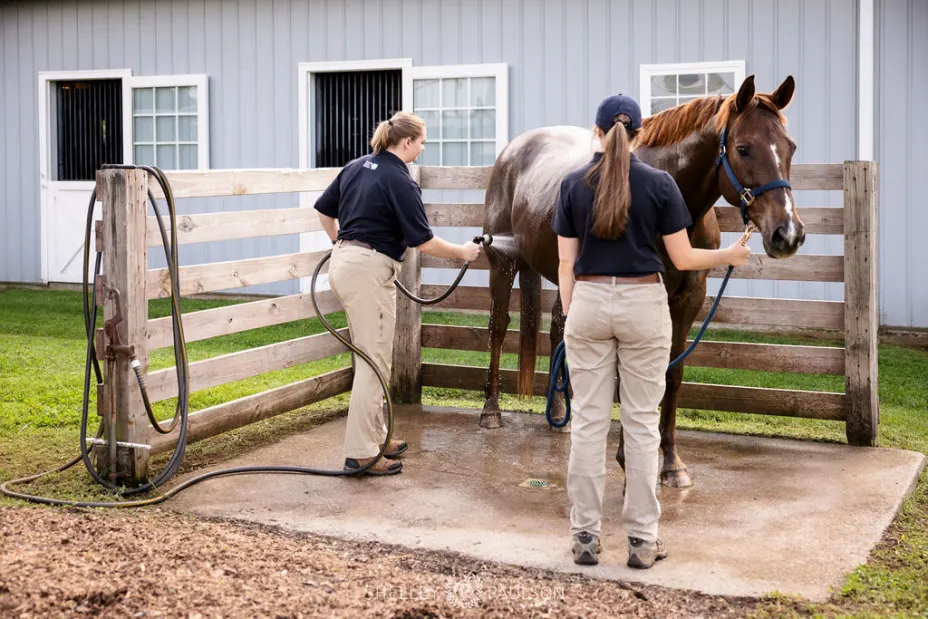Most horse owners have heard of electrolytes, a collective term for minerals, including sodium, chloride, potassium, calcium, and magnesium, but some may not understand how critical they are for hydration, nerve signaling, muscle contraction, and ultimately performance and health.
Electrolytes are typically offered reactively after sweaty training or competition rides, especially in extreme temperatures, or after signs of dehydration, fatigue, or muscle cramping appear. By this time, however, electrolyte imbalances have likely already hindered athleticism and delayed recovery. Many owners do not realize how quickly electrolyte depletion occurs and how detrimental it can be to overall well-being.
Horses in consistent work, even light exercise in cool environments, require daily electrolyte supplementation to satisfy baseline requirements. Inadequate electrolyte balance can lead to subtle but serious hydration and muscle problems, both of which affect performance.
Electrolyte Imbalances: Subtle Signs
Signs of electrolyte imbalances are often subtle or misattributed to other issues. These signs include:
- Fatigue or lack of energy,
- Sluggish performance or slow recovery,
- Muscle tightness, cramps, or tremors,
- Reduced, patchy, or delayed sweating, including anhidrosis,
- Excessive thirst, dehydration, or poor water intake, and
- Tying-up, known also as exertional rhabdomyolysis.
Indications of electrolyte imbalances do not appear only in hardworking horses; they often show up in light to moderately exercised horses when electrolyte needs are unfulfilled. Daily electrolyte supplementation is one of the simplest ways to avoid deficiencies.

Daily Losses: More Than Just Sweat
Electrolyte losses that occur through sweat are easy for horse owners to visualize, but electrolytes are also lost through less obvious routes: urination, defecation, respiration, and salivation.

While the main goal of electrolyte replenishment with exercising horses is to replace significant losses from sweat, it is important to not depend on a horse’s sweat pattern to determine electrolyte loss. A sweat pattern refers to the amount of sweating that occurs in different areas of a horse’s body, which can vary between individuals and be influenced by factors such as temperature, humidity, points of contact with tack or other equipment, and disposition. High-strung or nervous horses will often have an increased sweat response to certain situations.
ADVERTISEMENT
Supplementing by assessing sweat pattern may underestimate a horse’s actual electrolyte loss. Sweat evaporates quickly, especially during work and cooldown. Even exercise that leaves no visible sweat will increase electrolyte requirements due to shifts in fluid balance, muscle activity, and drinking or urination behavior. Just a few days of regular work without appropriate electrolyte replenishment can dull performance and slow recovery.
Sodium is Often Deficient
Sodium is the most critical electrolyte and is often the electrolyte most deficient in equine diets. In fact, 60-70% of horses are chronically deficient in sodium. Contrary to popular belief, voluntary intake from salt blocks is usually not enough to meet maintenance requirements for most horses. Regardless of workload, horses require a minimum of 1-2 oz (2-4 tablespoons) of plain salt (sodium chloride) daily just to replace basic sodium and chloride losses. Exercising horses lightly in moderate temperatures can increase requirements to 2-4 oz of salt per day.
Other Electrolytes Support Muscle Function

While salt makes up a significant portion of these losses, other electrolytes are also drained, including potassium, important for nerve and muscle function. Magnesium and calcium, vital for muscle contraction and relaxation, also diminish, but the amounts and ratios differ based on the type and duration of exercise. Prolonged low-intensity exercise (e.g., trail, endurance, ranch work) can increase magnesium and calcium losses. Potassium, magnesium, or calcium losses are more commonly associated with muscle fatigue, cramping, or spasms, and even tying-up.
General guidelines recommend using salt alone for horses at maintenance, but adding additional electrolytes even for light workloads, especially in hot or humid conditions. Consistently exercised horses (30-60 min/day) should consume both salt and additional electrolytes daily, gradually increasing as exercise intensity, heat, and humidity rise.
ADVERTISEMENT
Advantage of Slow-Release Technology
Osmolality refers to the delicate balance between water and electrolytes in the body. In horses, an equal concentration of water and electrolytes, called an isotonic state, is favored.
Large or sudden intakes of electrolytes or water can disrupt this balance, upset the digestive system, and change electrolyte excretion and retention rates. When large amounts of electrolytes are consumed, concentration of electrolytes into the gastrointestinal system can spike rapidly, drawing water into it to dilute the solution. When this happens, dehydration and diarrhea often result.
Further, large amounts of electrolytes can irritate the sensitive gastrointestinal lining, increasing the risk of ulcers, aggravating established ulcers, and causing sudden spikes in blood electrolyte levels. This can overwhelm the absorption capacity of the intestine and trigger the kidneys to increase urinary excretion, leading to “electrolyte dumping,” a term for rapid excretion of electrolytes. Dumping wastes valuable electrolytes at times when they are needed most by horses.
Encapsulation technology allows for a slow release of electrolytes over several hours, matching the natural absorption rate to maximize utilization, prevent waste, and promote consistent hydration. This steady delivery:
- Prevents sharp fluctuations in blood electrolyte levels, reducing the risk of osmotic shifts that result in fluid imbalances and electrolyte dumping,
- Avoids overwhelming the digestive system or kidneys, diminishing the likelihood of digestive upset or overexcretion, and
- Enhances electrolyte absorption and retention, encouraging sustained hydration.

Compared to other electrolytes, a slow-release electrolyte offers a safer, physiologically optimal alternative. By gradually delivering electrolytes, the gut and bloodstream can consistently maintain proper electrolyte and fluid balance. This allows for sustained absorption of electrolytes, ensuring they are available for proper muscle metabolism and performance recovery.
Rather than reactively offering electrolytes after depletion, daily supplementation of slow-release electrolytes allows for a proactive approach to maintain hydration and electrolyte availability, especially during sustained work or variable environmental conditions.
Research Is Our Key Ingredient™
Sign up for our biweekly newsletter and receive 10% off your first order. Be one of the first six to sign up and receive a personalized email and phone call from a Kentucky Equine Research nutrition advisor.
*Advertorial Content. The Chronicle of the Horse had no involvement in the creation of this content*





